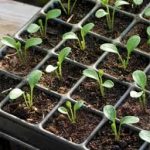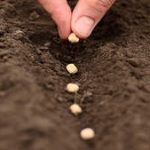GIY Weekly Column January 6th 2018 Growing In January And February
It may still be winter but now is the time to get started for year ahead. Don’t jump straight into seed sowing however, start with a little planning…
Low heat levels are the main reason that we can’t generally sow seeds in January and February – most seeds just won’t germinate when soil and air temperatures are low. But, low light levels are also a factor, as is the fact that there are only about 8-9 hours of daylight per day. A key problem with seeds sown at this time of the year is that the seedlings tend to become straggly or ‘leggy’ as they are literally straining for light. So, generally speaking you are as well to hold off until at least February before you start to sow seeds.
Having said that I often can’t wait to get started and at least plant something, perhaps some winter salad leaves, spinach and the like. If you are going to sow at this time of the year, it might help to get your hands on a propagator, which is designed to increase the temperature for seedlings so that you can start your seed sowing earlier. Generally speaking a propagator is a shallow container in to which you put your seed pots and trays – it has a removable plastic lid (often with a vent) that you take on and off depending on the temperature (for e.g. you might take it off by day if it’s mild and put it back on again at night).
Propagators can be (a) unheated, (b) heated or (c) heated with a thermostat control. An unheated propagator could be used indoors on a sunny windowsill at this time of the year. But it would probably be too cold at night to use it in a greenhouse. A heated propagator is more beneficial (though more expensive). A unit with a thermostat control will automatically set the temperature to the desired level. A sensor will detect when it’s too hot or cold and raise/lower the temp accordingly.
If you are raising a lot of seedlings and finding space in your propagator an issue, it might be worth investing in a heating mat. It’s a similar idea, but has a far larger surface area. My heating mat is about 2m long and has a heating element in it (much like an electric blanket) so the whole surface warms up. The mat rests on a worktop in the potting shed, and I place pots and seed trays on top to warm up. You can then cover the individual pots with cling-film or plastic covers (I find old fruit punnets useful here), or you can rig up a sort of cloche over them using coat hangers and some plastic.
The Basics – Things to Do This Month
To Do
Plan! This is a great month to decide where and what you are going to grow this year. If you are just starting out join your local GIY group for some advice and check out our website for handy “getting started” veg guides and videos. Consider building or buying some raised vegetable beds. There’s still time to spread well-rotted manure or compost on your vegetable beds and cover them down with black polythene to start warming them up for spring sowing. Start collecting old plastic bottles and containers as cloches and covers, and collect toilet roll inserts to use as pots for sowing. Order your seeds, onions sets and seed potatoes.
Harvest
January is a lean month in your first few years of GIYing and it requires foresight the previous spring/summer to ensure that you have things worth eating at this time of the year. You may have winter cabbage, perpetual spinach, chard, leeks, kale, cauliflowers and Brussels sprouts in your veggie patch and depending on how successful your growing/storage regime last year was, you may well still be tucking in to stores of potatoes, celeriac, carrots, parsnips, onions, cauliflower, jerusalem artichokes, winter squash, pumpkins, leeks and red cabbage.





